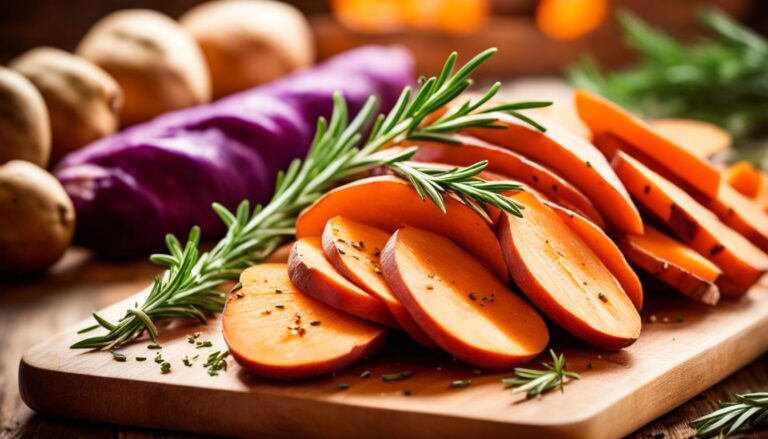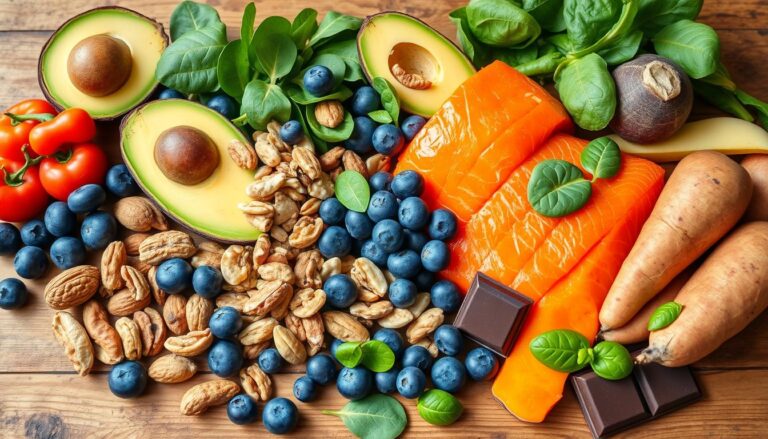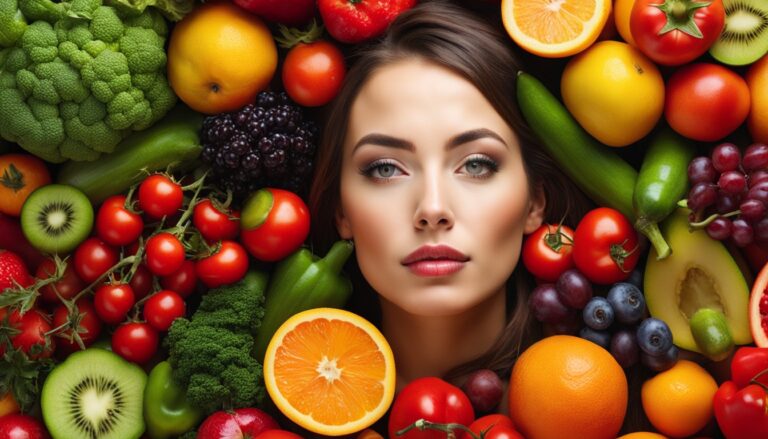Are you getting enough fruits and vegetables in your diet?
A diet rich in vegetables and fruits can have a significant impact on your overall health. Research has shown that consuming a variety of these foods can lower blood pressure reduce the risk of heart disease and stroke and prevent some types of cancer.
As part of a healthy diet vegetables and fruits provide essential nutrients that keep your body functioning properly. In this article, we will explore the importance of including a variety of fruits and vegetables in your daily meals.
Key Takeaways
- Understand the importance of fruits and vegetables in a healthy diet
- Learn about the current dietary recommendations for fruits and vegetables consumption
- Discover the nutritional composition of various fruits and vegetables
- Find out how to increase your daily intake of fruits and vegetables
- Understand the link between fruits and vegetables consumption and reduced risk of chronic diseases
The Power of Fruits and Vegetables in Your Diet
A diet rich in fruits and vegetables can have a significant impact on our health from reducing disease risk to enhancing overall nutrition. At least nine different families of fruits and vegetables exist, each with potentially hundreds of different plant compounds that are beneficial to health.
Eating a variety of types and colors of produce is essential to give our bodies the mix of nutrients it needs. This not only ensures a greater diversity of beneficial plant chemicals but also creates eye-appealing meals. The nutritional density of fruits and vegetables makes them ideal foods for maintaining a healthy weight while providing maximum nutritional benefit.
Why Fruits and Vegetables Are Essential for Health
Fruits and vegetables form the foundation of a healthy diet, providing essential vitamins minerals, fiber, and phytochemicals that support optimal bodily functions.
The unique combination of nutrients found in produce cannot be replicated by supplements or other food groups making fruits and vegetables irreplaceable in the human diet. Different colored fruits and vegetables contain different phytonutrients which is why eating a rainbow of produce is recommended for comprehensive health benefits.
Current Consumption Trends in the United States
Despite clear dietary guidelines recommending that half our plate should consist of fruits and vegetables most Americans consume far less than the recommended amounts.
Current consumption trends show that only about 1 in 10 Americans meet the federal fruit and vegetable recommendations with consumption particularly low among men young adults, and those living in poverty. The gap between dietary recommendations and actual consumption has significant public health implications.
Understanding the factors that influence fruit and vegetable consumption patterns in the United States is crucial for addressing this gap. Cultural economic, and lifestyle factors all play a role in determining our dietary choices and examining these factors can help in developing strategies to improve fruits and vegetables intake.
Nutritional Composition of Fruits and Vegetables
The nutritional composition of fruits and vegetables is a critical aspect of understanding their role in maintaining overall health. These foods are rich in various nutrients including vitamins minerals dietary fiber and phytochemicals which provide numerous health benefits.
Vitamins and Minerals
Fruits and vegetables are nutritional powerhouses, containing essential micronutrients such as vitamins A, C, E, K, and various B vitamins. They are also rich in minerals like potassium magnesium, and calcium. For example, citrus fruits are high in vitamin C, while leafy greens are excellent sources of folate and vitamin K.
- Vitamin A: Important for vision, immune function, and skin health
- Vitamin C: Essential for immune function skin health, and iron absorption
- Vitamin K: Crucial for blood clotting and bone health
Dietary Fiber Content
The fiber content in fruits and vegetables varies significantly. Some like berries pears, and broccoli contain high amounts of both soluble and insoluble fiber. This fiber supports digestive health, helps regulate blood sugar levels, and contributes to the feeling of satiety aiding in weight management.
- Soluble fiber: Helps regulate blood sugar levels and lower cholesterol
- Insoluble fiber: Promotes digestive health and prevents constipation
Phytochemicals and Antioxidants
Fruits and vegetables are rich in phytochemicals including flavonoids carotenoids, and polyphenols. These compounds provide powerful antioxidant protection against cellular damage and inflammation playing a crucial role in preventing chronic diseases.
- Flavonoids: Found in berries, apples, and onions, they have anti-inflammatory properties
- Carotenoids: Present in tomatoes, carrots, and leafy greens, they act as antioxidants
Understanding Different Categories of Fruits and Vegetables
Fruits and vegetables come in various categories, each providing unique nutritional benefits. Eating a variety of these foods is essential for a well balanced diet. The key is to explore the produce aisle and choose something new, focusing on variety and color.
On most days, try to get at least one serving from each of the following categories: dark green leafy vegetables yellow or orange fruits and vegetables red fruits and vegetables legumes beans and peas, and citrus fruits.
It is also recommended to skip the potatoes and choose other vegetables that are packed with different nutrients and more slowly digested carbohydrates.
Dark Green Leafy Vegetables
Dark green leafy vegetables like spinach, kale, and collard greens are nutritional standouts. They are packed with vitamins A, C, and K, folate, iron, calcium, and powerful antioxidants that support eye health and reduce cancer risk.

Red and Orange Vegetables
Red and orange vegetables such as carrots, sweet potatoes, and tomatoes are rich in carotenoids, particularly beta carotene and lycopene. These compounds support immune function and may reduce the risk of certain cancers.
Starchy Vegetables
Starchy vegetables including corn, peas, and potatoes provide more calories and carbohydrates than other vegetables. They are important energy sources though they should be consumed in appropriate portions.
Beans and Legumes
Beans and legumes serve as excellent sources of plant protein, fiber, iron, and zinc. They function as both a vegetable and protein source in the diet, supporting heart health and blood sugar regulation.
Understanding these different categories helps ensure dietary variety and comprehensive nutrient intake.
Each group offers a unique nutritional profile, and the USDA’s dietary guidelines recommend varying your vegetables to include foods from all these subgroups throughout the week for optimal health benefits.
| Category | Examples | Key Nutrients |
|---|---|---|
| Dark Green Leafy | Spinach, kale, collard greens | Vit A, C, K, folate, iron, calcium |
| Red and Orange | Carrots, sweet potatoes, tomatoes | Carotenoids, beta-carotene, lycopene |
| Starchy | Corn, peas, potatoes | Carbohydrates, energy |
| Beans and Legumes | Beans, lentils, peas | Plant protein, fiber, iron, zinc |
Eat Plenty of Fruits and Vegetables How Much Do You Need?
Eating a balanced diet rich in fruits and vegetables is vital, but determining the right quantity can be challenging. The dietary guidelines provide a clear direction on this matter.
According to the current Dietary Guidelines for Americans, adults are recommended to consume 1.5-2 cups of fruit and 2-3 cups of vegetables daily.
These amounts may vary based on factors such as age, gender, and activity level. For most adults, this translates to filling half their plate with fruits and vegetables at each meal, or consuming 5-9 servings per day.
Recommended Daily Servings
The recommended daily intake of fruits and vegetables is not one size fits-all. For instance children require smaller amounts though proportionally similar with recommendations increasing as they grow older. The MyPlate visual guide simplifies these recommendations by suggesting that fruits and vegetables should occupy half of your plate at each meal.
Research supports that these recommended amounts are the minimum needed to reduce the risk of chronic diseases, with additional benefits observed at higher intake levels. Different countries have slightly different recommendations, but all stress the importance of consuming a substantial amount of fruits and vegetables for optimal health.
What Counts as a Serving?
Understanding what constitutes a serving is crucial for meeting the daily recommendations. Generally, one serving equals 1 cup of raw leafy vegetables, ½ cup of other vegetables, 1 medium fruit, or ½ cup of chopped fruit.
Tracking your intake can be helpful initially to ensure you’re meeting the recommendations. However, developing an intuitive sense for proper portions is ideal over time. The table below provides a quick reference to the serving sizes for different types of fruits and vegetables.
| Food | Serving Size | Examples |
|---|---|---|
| Raw leafy vegetables | 1 cup | Lettuce, spinach |
| Other vegetables | ½ cup | Broccoli, carrots |
| Fruits | 1 medium or ½ cup chopped | Apple, banana |
The Role of Dietary Fiber in Fruits and Vegetables
The role of dietary fiber in fruits and vegetables is multifaceted, contributing significantly to our well being.
Dietary fiber essentially the undigested carbohydrates in our diet plays a crucial role in health maintenance. Most Americans consume far less than the recommended 25-30 grams daily making it essential to understand and incorporate fiber-rich foods into our diets.
Soluble vs. Insoluble Fiber
Dietary fiber is categorized into two main types: soluble and insoluble fiber. Soluble fiber, found in fruits like apples citrus, and berries dissolves in water to form a gel like substance. This helps in lowering cholesterol levels and regulating blood glucose.
On the other hand, insoluble fiber predominant in vegetables, whole grains, and fruit skins, adds bulk to stool and aids in preventing constipation by facilitating the passage of food through the digestive system.
Most fruits and vegetables contain both types of fiber with the total fiber content varying significantly across different produce. For instance, some fruits and vegetables may contain less than 1 gram of fiber per serving, while others may contain over 5 grams.
Health Benefits of Fiber
The health benefits of dietary fiber extend far beyond digestive health. A high-fiber diet is associated with a reduced risk of heart disease, type 2 diabetes, and certain cancers. The fiber from whole fruits and vegetables is generally more beneficial than isolated fiber supplements due to the synergistic effects of fiber with other nutrients and phytochemicals.
To reap the benefits of dietary fiber, it’s recommended to increase intake gradually allowing the digestive system to adjust, and to accompany this with adequate fluid intake to prevent discomfort.
Moreover consuming whole, minimally processed produce is preferable as processing methods like peeling can significantly reduce the fiber content of fruits and vegetables.
Fruits Vegetables and Cardiovascular Health
Cardiovascular disease is a leading cause of death globally, but a diet rich in fruits and vegetables can significantly reduce this risk. A comprehensive analysis of various studies has shown that a higher intake of fruits and vegetables is associated with a lower risk of heart disease and stroke.
Impact on Heart Disease Risk
A meta-analysis of cohort studies involving 469,551 participants found that for each additional serving per day of fruits and vegetables the risk of death from cardiovascular disease decreased by an average of 4%. Those who consumed 8 or more servings daily were 30% less likely to have a heart attack or stroke compared to those who had less than 1.5 servings daily.
Effects on Blood Pressure
Fruits and vegetables help lower blood pressure through several mechanisms, including their high potassium content which counteracts the effects of sodium. The DASH diet rich in fruits and vegetables has been shown to lower blood pressure as effectively as some medications, reducing systolic pressure by 8-14 mmHg.
Best Fruits and Vegetables for Heart Health
Green leafy vegetables, cruciferous vegetables, and citrus fruits are particularly beneficial for cardiovascular health. Berries like blueberries and strawberries contain anthocyanins that improve endothelial function and reduce inflammation, directly benefiting heart health.
A study published in a reputable journal highlighted that a diet rich in fruits and vegetables can lower the risk of cardiovascular disease by reducing blood pressure, improving lipid profiles, and providing essential nutrients and antioxidants.
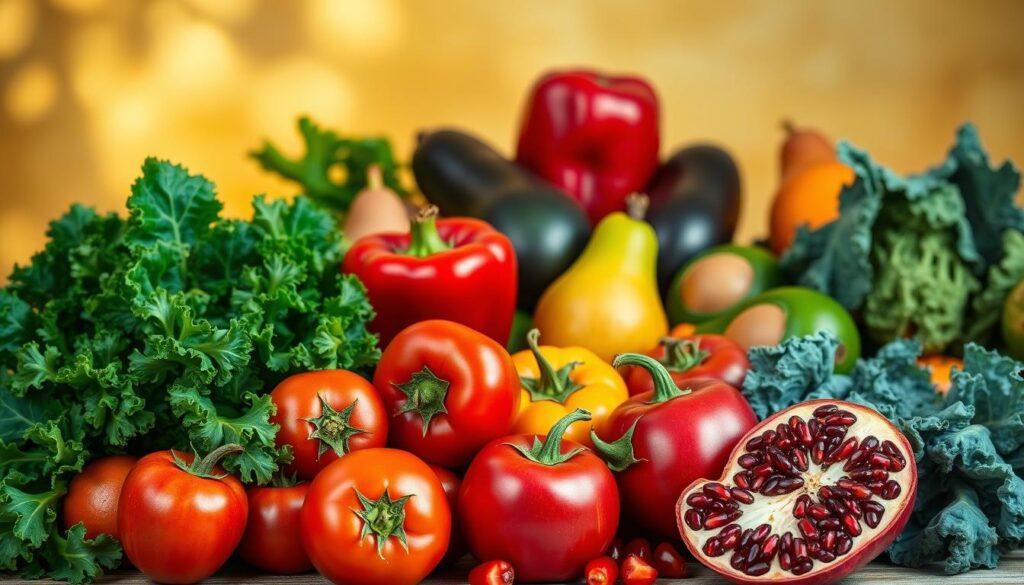
| Fruit/Vegetable | Benefit |
|---|---|
| Green Leafy Vegetables | Rich in potassium, vitamins, and minerals |
| Berries Blueberries, Strawberries | High in anthocyanins, antioxidants |
| Citrus Fruits | Rich in vitamin C, flavonoids |
In conclusion, incorporating a variety of fruits and vegetables into one’s diet is a crucial step in maintaining cardiovascular health. The evidence from numerous studies underscores the importance of these foods in reducing the risk of heart disease and stroke.
Cancer Prevention and Fruits and Vegetables
Eating a diet rich in fruits and vegetables has been consistently associated with a lower risk of various types of cancer. The relationship between fruit and vegetable consumption and cancer risk has been the subject of numerous studies.
Research has shown that certain fruits and vegetables have anti cancer properties, and that a diet high in these foods can have a significant impact on reducing the risk of certain cancers.
Current Research on Cancer Risk Reduction
Studies have found that higher fruit and vegetable intake is associated with reduced risk of certain cancers particularly those of the digestive tract respiratory system, and hormone related cancers.
For example a study by Farvid and colleagues followed a cohort of 90,476 premenopausal women for 22 years and found that those who ate the most fruit during adolescence had a 25% lower risk of developing breast cancer.
After following 182,145 women in the Nurses’ Health Study I and II for 30 years Farvid’s team also found that women who ate more than 5.5 servings of fruits and vegetables each day had an 11% lower risk of breast cancer compared to those who ate 2.5 or fewer servings.
Specific Fruits and Vegetables with Anti-Cancer Properties
Certain fruits and vegetables have been found to have anti-cancer properties. For instance, cruciferous vegetables like broccoli cauliflower, and cabbage contain glucosinolates that break down into compounds with demonstrated anti-cancer properties in laboratory studies.
Other examples include tomatoes and tomato products that contain lycopene, which has been associated with reduced risk of prostate cancer, and berries that are rich in ellagic acid and anthocyanins that have been shown to inhibit cancer cell growth and reduce inflammation in experimental studies.
Some Allium vegetables like garlic and onions contain organosulfur compounds that may inhibit cancer formation and growth through multiple mechanisms.
Managing Diabetes with Fruits and Vegetables
For individuals with diabetes, consuming a balanced diet that includes a variety of fruits and vegetables is crucial for maintaining healthy blood sugar levels. Research has shown that certain fruits, particularly berries apples, and grapes are associated with a lower risk of developing type 2 diabetes. The fiber in these foods plays a significant role in regulating blood glucose levels.
Impact on Blood Sugar Levels
The fiber in fruits and vegetables slows down the absorption of carbohydrates, preventing rapid spikes in blood sugar and improving overall glycemic control.
Studies have found that non-starchy vegetables like leafy greens, broccoli, and peppers have a minimal impact on blood sugar levels making them ideal choices for individuals with diabetes. Moreover, the glycemic index and glycemic load of different fruits vary, with berries, cherries, and citrus fruits generally having less impact on blood glucose than tropical fruits like bananas and pineapple.
Best Choices for Diabetics
When it comes to managing diabetes through diet, choosing the right fruits and vegetables is essential.
Whole fruit is preferred over fruit juice because juicing removes fiber and concentrates sugars, potentially causing rapid blood glucose elevation.
Portion control remains important even with lower glycemic fruits, as total carbohydrate intake affects blood sugar management. Incorporating vegetables as the largest component of meals can help displace higher glycemic foods, improving overall glycemic response and supporting weight management, a key factor in diabetes control.
Weight Management Benefits
Eating a variety of fruits and vegetables can play a significant role in maintaining a healthy weight. The nutritional properties of these foods make them ideal for weight management.
The role of fruits and vegetables in weight management is supported by their low energy density and high satiety levels. This means that they can help individuals feel fuller for longer without consuming too many calories.
Low Energy Density and Satiety
Fruits and vegetables are characterized by their low energy density due to their high water and fiber content. This allows for larger portions with fewer calories making them very filling. The fiber in these foods promotes satiety by slowing down digestion, increasing stomach distension, and influencing gut hormone production that signals fullness to the brain.
For instance, a study found that individuals who consumed more fruits and vegetables tended to have a lower overall caloric intake. The volume of these foods helps create a feeling of fullness, reducing the likelihood of overeating.
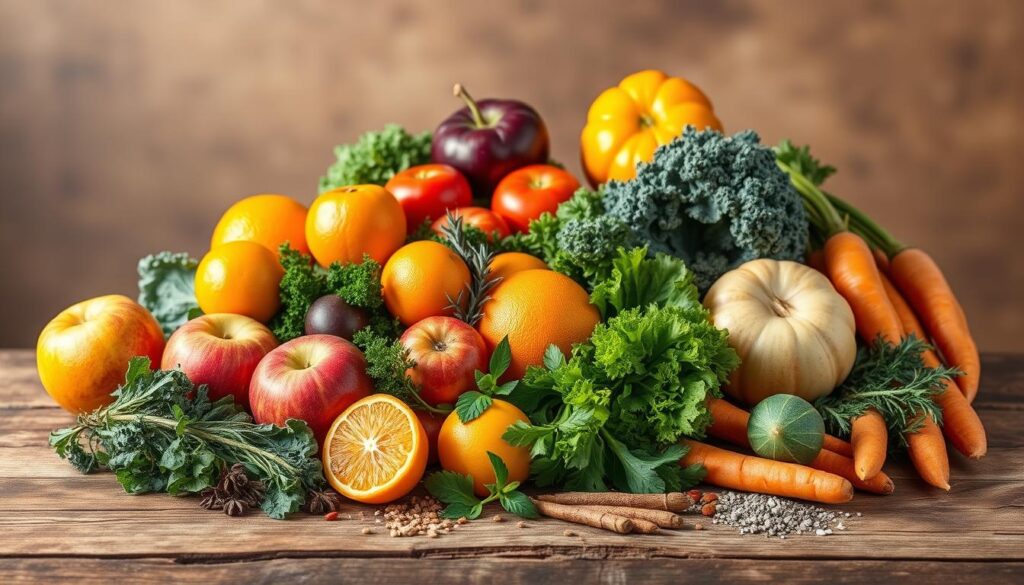
Research on Weight Loss and Maintenance
Research from the Nurses’ Health Studies and the Health Professionals’ Follow up Study has shown that individuals who increased their intake of fruits and vegetables over a 24-year period were more likely to lose weight.
Specifically foods like berries, apples, pears, and cauliflower were associated with weight loss, while starchier vegetables like potatoes were linked with weight gain.
A key finding from these studies is that it is not just the addition of fruits and vegetables to the diet that aids in weight loss, but rather their substitution for higher-calorie foods. This substitution results in a natural reduction in overall caloric intake.
Some key aspects of how fruits and vegetables contribute to weight management include:
- Low energy density due to high water and fiber content
- Promotion of satiety through various mechanisms
- Creation of visual and physical fullness with meals
- Slowing down of digestion and influence on gut hormones
- Strategic incorporation before and during meals to reduce intake of energy-dense foods
Research supports the role of specific fruits and vegetables in weight management. For example, a diet rich in berries, apples, and non-starchy vegetables like cauliflower can aid in weight loss and maintenance.
| Fruits/Vegetables | Weight Loss Association | Main Benefits |
|---|---|---|
| Berries, Apples, Pears | Strong | High fiber, low energy density |
| Cauliflower | Strong | Low calories, high fiber |
| Potatoes, Corn | Low | High starch content |
Fruits Vegetables and Digestive Health
Incorporating a diverse range of fruits and vegetables into one’s diet can lead to improved digestive well-being. The fiber content in these foods plays a crucial role in maintaining a healthy gut.
Gut Microbiome Benefits
The fiber in fruits and vegetables serves asprebiotics, feeding beneficial gut bacteria and promoting a diverse healthy microbiome. This is associated with improved immune function and reduced inflammation.
Regular consumption of a variety of fruits and vegetables introduces different types of fiber that support different beneficial bacterial populations in the gut. Some key benefits include:
- Promoting a diverse gut microbiome
- Supporting beneficial bacteria
- Enhancing immune function
Prevention of Digestive Disorders
The insoluble fiber in fruits and vegetables adds bulk to stool and speeds transit time through the digestive tract, helping to prevent constipation.
Soluble fiber from fruits like apples and citrus forms a gel-like substance that can help manage diarrhea and regulate bowel movements. Additionally, certain fruits contain enzymes that aid digestion, such as papaya papain and pineapple bromelain, which help break down proteins.
A higher intake of fruits and vegetables is associated with a reduced risk of diverticular disease, as fiber decreases pressure within the colon. The anti-inflammatory compounds in colorful fruits and vegetables may also help reduce inflammation in the digestive tract, potentially benefiting conditions like inflammatory bowel disease.
Eye Health and Vision Protection
Maintaining eye health is crucial as we age, and a diet rich in fruits and vegetables can play a significant role in protecting our vision. Consuming a variety of these foods can help prevent common aging-related eye diseases such as cataracts and macular degeneration, which affect millions of Americans over 65.
Nutrients That Support Eye Health
Specific nutrients found abundantly in fruits and vegetables are crucial for maintaining eye health. Lutein and zeaxanthin, carotenoids found in dark green leafy vegetables, corn, and egg yolks, accumulate in the macula of the eye filtering harmful blue light and neutralizing free radicals.
Vitamin C, abundant in citrus fruits, strawberries, and bell peppers, supports the health of blood vessels in the eye. Vitamin A and its precursor beta-carotene, found in orange vegetables like carrots and sweet potatoes, are essential for proper retinal function and night vision.
Prevention of Age Related Eye Conditions
Multiple studies have shown that high intake of lutein and zeaxanthin is associated with a significantly reduced risk of age-related macular degeneration (AMD), the leading cause of blindness in older adults.
The antioxidants in colorful fruits and vegetables help protect delicate eye tissues from oxidative damage. Long-term studies suggest that people who consume diets rich in fruits and vegetables have a 20-40% lower risk of developing cataracts and AMD compared to those with low intake.
| Nutrient | Food Sources | Benefit to Eye Health |
|---|---|---|
| Lutein and Zeaxanthin | Dark green leafy vegetables, corn, egg yolks | Filter harmful blue light, neutralize free radicals |
| Vitamin C | Citrus fruits, strawberries, bell peppers | Support health of blood vessels in the eye |
| Vitamin A and Beta-Carotene | Orange vegetables like carrots and sweet potatoes | Essential for retinal function and night vision |
Fresh vs. Frozen vs. Canned: Making Smart Choices
Understanding the nutritional differences and benefits of fresh, frozen, and canned fruits and vegetables is crucial for making informed dietary choices. As we delve into the details of each type, it becomes clear that each has its own advantages and disadvantages.
Nutritional Differences
The nutritional content of fruits and vegetables can vary significantly depending on whether they are consumed fresh, frozen, or canned.Fresh produceis often considered the gold standard, but it begins to lose nutrients immediately after harvest. For instance,vitamin Cis particularly susceptible to degradation over time.
On the other hand,frozen fruits and vegetablesare typically processed within hours of being picked, which helps retain their nutrients. However, the blanching process before freezing can cause some loss of water-soluble vitamins.
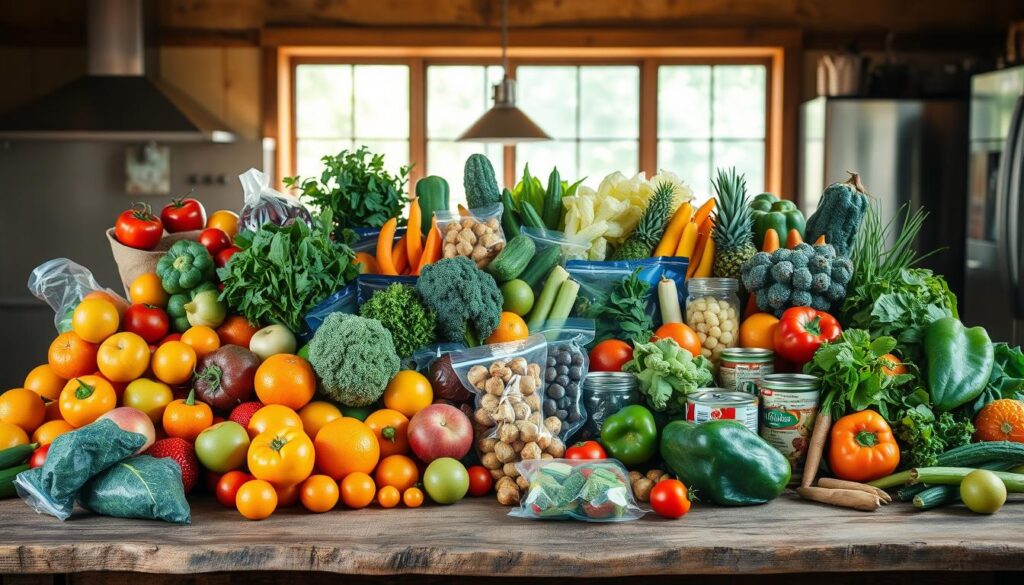
Canned fruits and vegetables retain most minerals and fat-soluble vitamins, but the heating process during canning can lead to the loss of water-soluble vitamins. Moreover, canned goods often contain added sodium or sugar, which should be considered when making dietary choices.
When to Choose Each Option
The choice between fresh, frozen, and canned fruits and vegetables depends on several factors, including availability, budget, and convenience.Fresh, locally grown produceis ideal when available, as it generally offers optimal nutrition and flavor. For example, visiting farmers’ markets or purchasing from local sources can provide the freshest produce.
However,frozen fruits and vegetablesprovide a convenient and nutritious alternative, especially when fresh produce is out of season. They allow for year-round access to a wide variety of fruits and vegetables.Canned optionsare shelf-stable and economical, making them valuable pantry staples. Some nutrients, likelycopene in canned tomatoes, become more bioavailable due to the canning process.
In conclusion, making smart choices involves using a combination of fresh, frozen, and canned fruits and vegetables based on availability, budget, and specific recipe requirements. By understanding the nutritional differences and benefits of each, consumers can make informed decisions to maintain a balanced diet rich in fruits and vegetables.
Practical Tips to Increase Your Fruit and Vegetable Intake
Boosting your intake of fruits and vegetables can be achieved with a few simple strategies. Incorporating more of these foods into your diet can have a significant impact on your overall health.
Making Fruits and Vegetables More Accessible
One of the key factors in increasing your consumption of fruits and vegetables is making them easily accessible. Keeping washed and ready-to-eat fruits and vegetables at eye level in your refrigerator or in visible bowls on countertops can significantly impact your consumption.
For instance, placing a bowl of fresh fruits on your kitchen counter or storing chopped colorful fruits in a glass bowl in the refrigerator can tempt you to snack on them more often.
Creative Ways to Add More Produce to Meals
Adding vegetables to dishes you already enjoy is a great way to increase your intake. You can incorporate grated vegetables into pasta sauces, casseroles, and baked goods, or add extra vegetables to sandwiches, wraps, and pizzas.
Experimenting with different preparation methods can also make vegetables more appealing. For example, roasting brings out the natural sweetness in vegetables, while different seasonings can transform their flavor profile.
Overcoming Common Barriers
Several common barriers can prevent people from consuming enough fruits and vegetables, including cost and time constraints.
Focusing on seasonal produce, utilizing frozen options, and taking advantage of sales and farmers’ markets can help address cost barriers. To overcome time constraints, you can utilize pre-cut options when necessary, incorporate quick-cooking vegetables like leafy greens, and batch-prepare vegetables for multiple meals.
Kid-Friendly Strategies
Involving children in the selection and preparation of fruits and vegetables can encourage them to eat more of these foods.
Modeling positive attitudes toward produce, offering vegetables with dips, and incorporating fruits and vegetables into their favorite dishes are also effective strategies. Making fruits and vegetables the default snack option by having them prepared and readily available can help develop healthy eating habits in children.
By implementing these strategies, you can increase your intake of fruits and vegetables and enjoy the numerous health benefits associated with a diet rich in these foods.
Addressing Common Concerns About Fruits and Vegetables
While fruits and vegetables are essential for a healthy diet, some concerns related to their consumption need clarification. Several issues, including pesticide residues, the nutritional value of fruit juice versus whole fruits, and the impact of starchy vegetables on carbohydrate intake, are commonly raised by consumers.
Pesticides and Organic Options
Concerns about pesticide residues on conventional produce are common; however, research shows that the health benefits of eating fruits and vegetables far outweigh potential risks.
The Environmental Working Group’s Dirty Dozen and Clean Fifteen lists can help consumers make informed choices about which produce items to buy organic if budget constraints exist. Washing fruits and vegetables thoroughly with water is also effective in removing most surface pesticide residues.
Fruit Juice vs. Whole Fruits
Consuming fruit juice has been associated with a higher risk of type 2 diabetes in some studies. Unlike whole fruits, fruit juice lacks fiber and contains concentrated sugars, causing rapid blood sugar spikes. While small amounts of 100% juice can be part of a healthy diet, it is generally recommended to consume whole fruits for their nutritional benefits.
Starchy Vegetables and Carbohydrate Concerns
Starchy vegetables like potatoes, corn, and peas provide more calories and carbohydrates than non-starchy vegetables but still offer valuable nutrients. When portion-controlled, these vegetables can be part of a healthy diet.
The method of preparation significantly impacts their nutritional profile; for example, baked potatoes are a nutritious whole food, whereas french fries add substantial fat and sodium.
Creating a Balanced Eating Plan with Fruits and Vegetables
Creating a balanced eating plan that includes a variety of fruits and vegetables is crucial for maintaining good health. The Dietary Guidelines for Americans 2010 recommend making one-half of your plate fruits and vegetables. This guideline is also supported by Myplate.gov, emphasizing the importance of these food groups in our diet.
As we strive to follow these guidelines, it is essential to understand how to incorporate the recommended 5-9 servings of fruits and vegetables per day into our meals. The USDA’s MyPlate model provides a simple and effective way to achieve this by filling half your plate with fruits and vegetables at each meal, with a slightly greater emphasis on vegetables.
Sample Meal Plans
Creating sample meal plans can help demonstrate how to distribute fruit and vegetable servings throughout the day.
For example, breakfast might include fruit with cereal or yogurt lunch could feature a large salad, and dinner should include at least two vegetable servings. A well-planned meal plan ensures that we meet our daily intake of 5-9 servings of fruits and vegetables per day.
For instance, a sample meal plan could be:
- Breakfast: Oatmeal with banana and berries
- Lunch: Grilled chicken salad with mixed greens, vegetables, and fruit
- Dinner: Steamed broccoli, carrots, and a baked potato with grilled chicken
Shopping and Storage Tips
Strategic shopping and proper storage are crucial for maintaining a steady supply of fruits and vegetables. When shopping, create a produce-focused list, purchase a variety of colors and types, and consider what is in season for optimal flavor and affordability.
Proper storage can significantly extend the life of produce. Some items like tomatoes and bananas should be kept at room temperature while most others benefit from refrigeration.
It is also important to store ethylene producing fruit like apples bananas, and avocados separately from ethylene-sensitive produce to prevent premature ripening and spoilage.
As we incorporate more fruits and vegetables into our diet, we should also consider meal preparation techniques like batch cooking vegetables, preparing salads in advance, and freezing extra fruit for smoothies. This will help streamline healthy eating and ensure that we maintain a balanced diet.
Conclusion
A diet rich in fruits and vegetables has been consistently shown to have a positive effect on various aspects of health, from cardiovascular well-being to cancer prevention. The scientific evidence overwhelmingly supports the recommendation to eat plenty of fruits and vegetables as a cornerstone strategy for promoting health and preventing disease.
The protective effects of fruits and vegetables extend to multiple body systems reducing the risk of coronary heart disease stroke type 2 diabetes certain cancers, and age related eye diseases.
Consuming a variety of these foods provides a unique combination of nutrients fiber, and phytochemicals that cannot be replicated by supplements or other food groups.
Green leafy vegetables, berries, citrus fruits, and orange vegetables consistently show the strongest associations with disease prevention in epidemiological studies. Moreover, the fiber in fruits and vegetables supports digestive health, helps maintain a healthy weight, and contributes to stable blood sugar levels.
To reap these benefits, the current dietary guidelines recommend filling half your plate with fruits and vegetables at each meal. It’s also important to choose whole fruits over fruit juice, as they provide fiber and are less likely to cause a spike in blood glucose levels.
In conclusion, incorporating a wide variety of fruits and vegetables into your diet is a simple yet effective way to improve your health outcomes and reduce the risk of chronic diseases.
